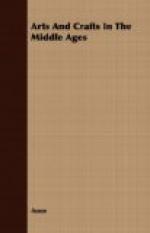Veit Stoss was a very versatile craftsman. Besides his wonderful wood carvings, for which he is chiefly noted, he was a bridge-builder, a stone-mason, a bronze caster, painter of altars, and engraver on copper! Like all such variously talented persons, he suffered somewhat from restlessness and preferred work to peace,—but his compensation lay in the varied joys of creative works. His naturalism was marked in all that he did: a naive old chronicler remarks that he made some life-sized coloured figures of Adam and Eve, “so fashioned that one was afraid that they were alive!” Veit Stoss was an interesting individual. He was not especially moral in all his ways, narrowly escaping being executed for forgery; but his brilliancy as a technician was unsurpassed. He lived until 1533, when he died in Nueremberg as a very old man. One of his most delightful achievements is the great medallion with an open background, which hangs in the centre of the Church of St. Lorenz. It shows two large and graceful figures,—Mary and the Angel Gabriel, the subject being the Annunciation. A wreath of angels and flowers surrounds the whole, with small medallions representing the seven joys of the Virgin. It is a masterly work, and was presented by Anton Tucher in 1518. Veit Stoss was the leading figure among wood carvers of the Renaissance, although Albrecht Duerer combined this with his many accomplishments, as well.
Some of the carvings in wood in the chapel of Henry VII. at Westminster, are adapted from drawings by Albrecht Duerer, and are probably the work of Germans. Two of these, Derrick van Grove and Giles van Castel, were working at St. George’s, Windsor, about the same time.
The very finest example of Nueremberg carving, however, is the famous wooden Madonna, which has been ascribed to Peter Vischer the Younger, both by Herr von Bezold and by Cecil Headlam. It seems very reasonable after a study of the other works of this remarkable son of Peter Vischer, for there is no other carver of the period, in all Nueremberg, who could have executed such a flawlessly lovely figure.
One of the noted wood carvers in Spain in the Renaissance, was Alonso Cano. He was a native of Granada and was born in 1601. His father was a carver of “retablos,” and brought the boy up to follow his profession. Cano was also a painter of considerable merit, but as a sculptor in wood he was particularly successful. His first conspicuous work was a new high altar for the church of Lebrija, which came to him on account of the death of his father, who was commencing the work in 1630, when his life was suddenly cut off. Alonso made this altar so beautifully, that he was paid two hundred and fifty ducats more than he asked! Columns and cornices are arranged so as to frame four excellent statues. These carvings have been esteemed so highly that artists came to study them all the way from Flanders. The altar is coloured, like most of the Spanish retablos.




